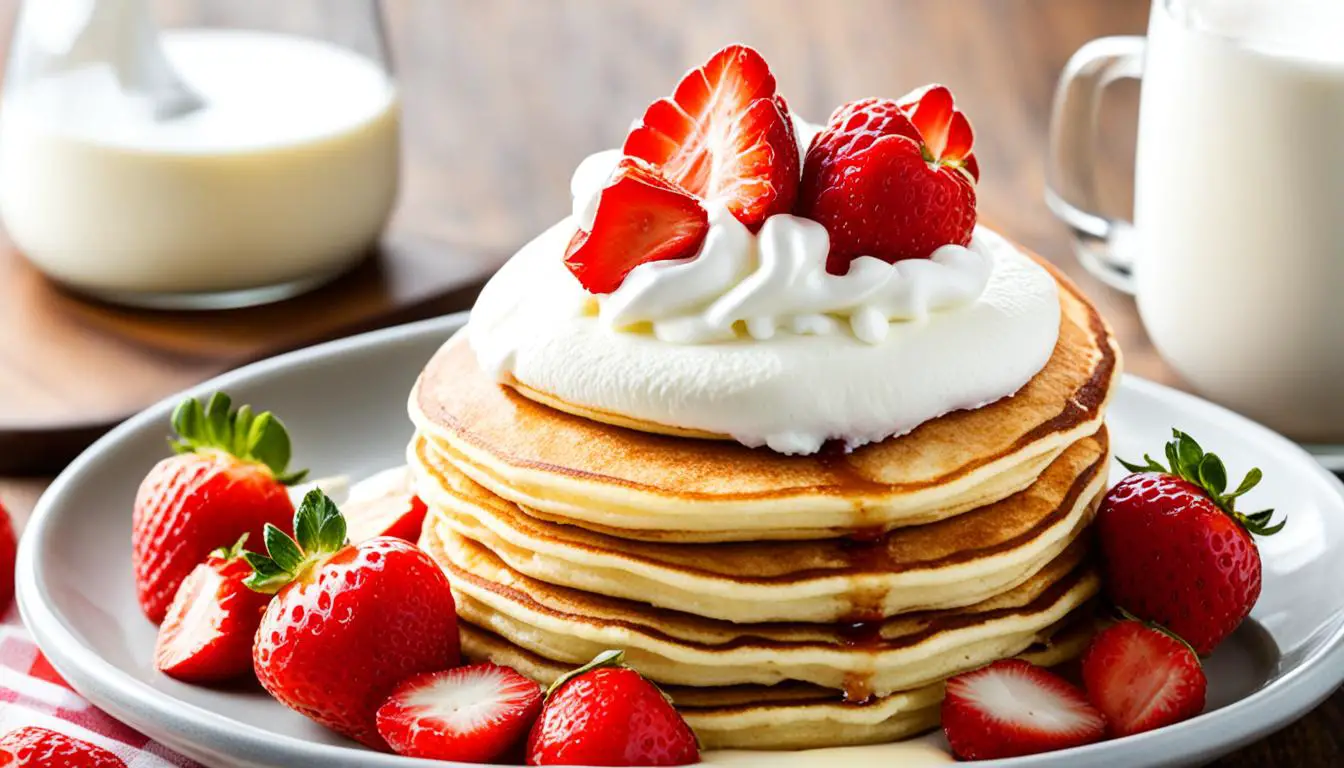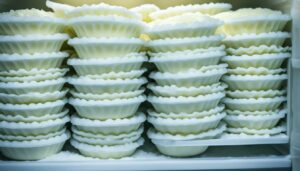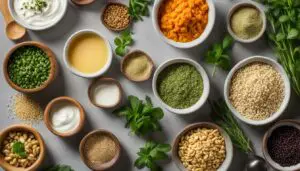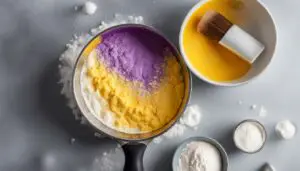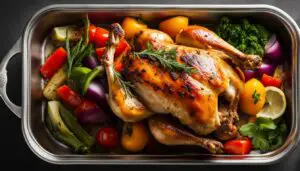Originally posted on February 10, 2024 @ 8:22 am
Buttermilk is a versatile ingredient that adds flavor and texture to a wide range of recipes. Whether you’re baking light and fluffy pancakes, marinating tender chicken, or creating creamy dressings and sauces, buttermilk brings a unique taste and tangy twist to your dishes. But what exactly is buttermilk and why should you use it in your cooking?
Buttermilk is a fermented, low-fat liquid that is a byproduct of making butter. It has a slightly sour flavor and a creamy consistency that enhances the overall taste of your recipes. While traditionally buttermilk was the liquid left after churning cream to produce butter, the buttermilk available in stores today is usually cultured buttermilk. This means that live cultures are added to skim or whole milk and allowed to ferment, creating a thicker and tangier version.
So why use buttermilk in your recipes? Here are some of the top benefits:
Contents
- 1 What is Buttermilk?
- 2 How to Use Buttermilk in Baking
- 3 Buttermilk as a Marinade
- 4 Buttermilk in Dressings and Sauces
- 5 Buttermilk in Other Recipes
- 6 How to Store Buttermilk
- 7 Buttermilk Substitutes
- 8 Traditional Uses of Buttermilk
- 9 Buttermilk Variations and Alternatives
- 10 Tips for Using Buttermilk in Recipes
- 11 Conclusion
- 12 FAQ
- 12.1 Why should I use buttermilk in recipes?
- 12.2 What is buttermilk?
- 12.3 How can I use buttermilk in baking?
- 12.4 How can buttermilk be used as a marinade?
- 12.5 How can buttermilk be used in dressings and sauces?
- 12.6 What other recipes can I use buttermilk in?
- 12.7 How should I store buttermilk?
- 12.8 What can I use as a substitute for buttermilk?
- 12.9 Are there traditional uses for buttermilk beyond cooking?
- 12.10 Are there variations of buttermilk or alternative products?
- 12.11 What are some tips for using buttermilk in recipes?
- 12.12 Can buttermilk be frozen?
- 13 Source Links
Key Takeaways:
- Buttermilk adds flavor and texture to a variety of recipes.
- It is commonly used in baked goods, marinades, dressings, and sauces.
- Buttermilk enhances the rise, tenderness, and moistness of baked goods.
- It tenderizes meat and stabilizes sauces due to its acidity.
- Buttermilk can be substituted with plain yogurt or milk mixed with vinegar or lemon juice.
What is Buttermilk?
Buttermilk is a fermented, low-fat liquid that is a byproduct of making butter. Traditionally, buttermilk was the liquid that was left after churning cream to produce butter. It would naturally ferment, thanks to the bacteria present in the cream, giving it a slightly sour flavor. However, the buttermilk available in stores today is usually cultured buttermilk, which is made by adding live cultures to skim or whole milk and allowing it to ferment. Cultured buttermilk has a thicker consistency, a pale golden color, and a tangy flavor. It is also acidic, which contributes to its unique taste and its ability to tenderize proteins and stabilize sauces.
How to Use Buttermilk in Baking
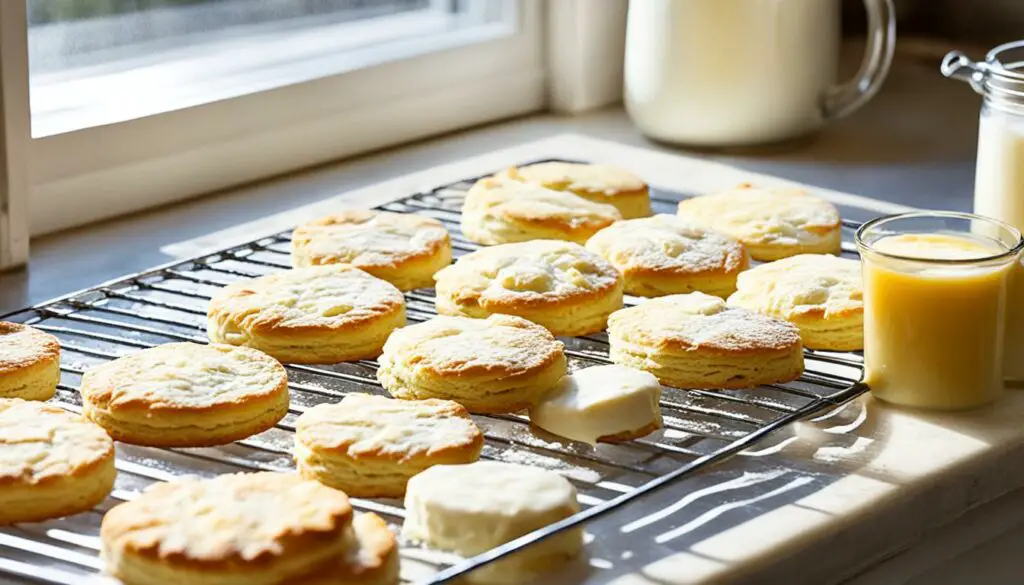
Buttermilk is a versatile and essential ingredient in baking, adding a tangy flavor and creating light, fluffy textures in various recipes. It enhances the rise and tenderness of pancakes, waffles, biscuits, and cakes, making them irresistibly delicious. Let’s explore how to use buttermilk in baking and discover the secrets behind its magical transformation.
When it comes to pancakes, buttermilk is a game-changer. The acidity of buttermilk reacts with leavening agents like baking soda, producing carbon dioxide bubbles that make the batter rise and result in perfectly fluffy pancakes. Buttermilk also infuses a subtle tanginess, adding complexity to the flavor profile.
Buttermilk’s tenderizing properties make it ideal for creating soft, melt-in-your-mouth biscuits. The acidity breaks down gluten strands, resulting in tender, buttery biscuits with a tender crumb.
In cakes, buttermilk acts as a moisture-retaining agent, keeping the crumb moist and preventing dryness. It adds a lovely tang and enhances the overall flavor, making your cakes even more delectable.
Easy Buttermilk Pancakes Recipe
| Ingredients | Instructions |
|---|---|
|
|
With just a few simple steps, you can create fluffy and flavorful pancakes that will impress your family and friends.
Buttermilk’s versatility doesn’t end here. It can also be used in muffins, scones, cornbread, and other baked treats, adding a delightful tang and moisture to the final result. The possibilities are endless!
So the next time you head to the kitchen to bake, don’t forget to reach for the buttermilk. It’s the secret ingredient that will take your baked goods to new heights of deliciousness.
Buttermilk as a Marinade
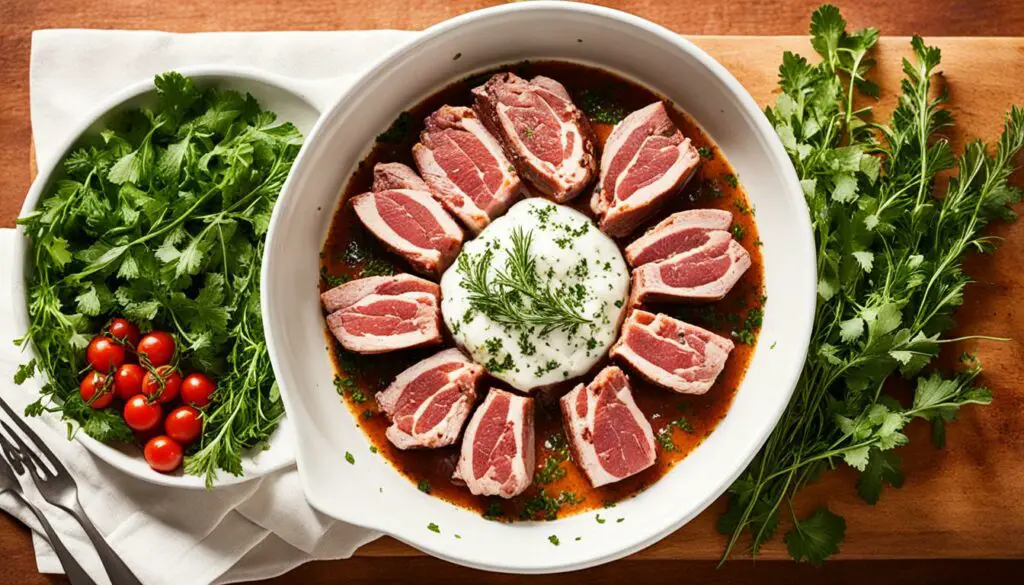
When it comes to tenderizing meat and infusing it with a subtle tangy flavor, buttermilk is a tried and true marinade option. The acid in buttermilk breaks down the tougher fibers of the meat, resulting in more tender and juicy dishes. It’s no wonder that buttermilk is a popular choice for making juicy and flavorful fried chicken.
To use buttermilk as a marinade, simply submerge the meat in a bath of buttermilk and let it sit for a few hours or overnight in the refrigerator. The buttermilk works its magic, tenderizing the meat and enhancing its taste. Whether you’re marinating chicken breasts or pork chops, buttermilk is a game-changer in the kitchen.
“The acid in buttermilk helps to break down the tougher fibers of the meat, resulting in more tender and flavorful dishes.”
Try this simple buttermilk marinade recipe for mouthwatering results:
- 1 cup of buttermilk
- 2 cloves of minced garlic
- 1 tablespoon of fresh herbs (such as parsley, thyme, or rosemary)
- 1 teaspoon of salt
- 1/2 teaspoon of black pepper
Combine all the ingredients in a bowl or zip-top bag. Add the meat and make sure it is fully coated in the marinade. Refrigerate for at least 2 hours, or overnight for the best results. Grill, bake, or fry the marinated meat as desired, and enjoy the tender and flavorful outcome.
Using buttermilk as a marinade adds a unique touch to your cooking, tenderizing the meat and bringing out its best flavors. So, the next time you’re looking to elevate your dishes and impress your guests, give buttermilk a try.
Buttermilk in Dressings and Sauces
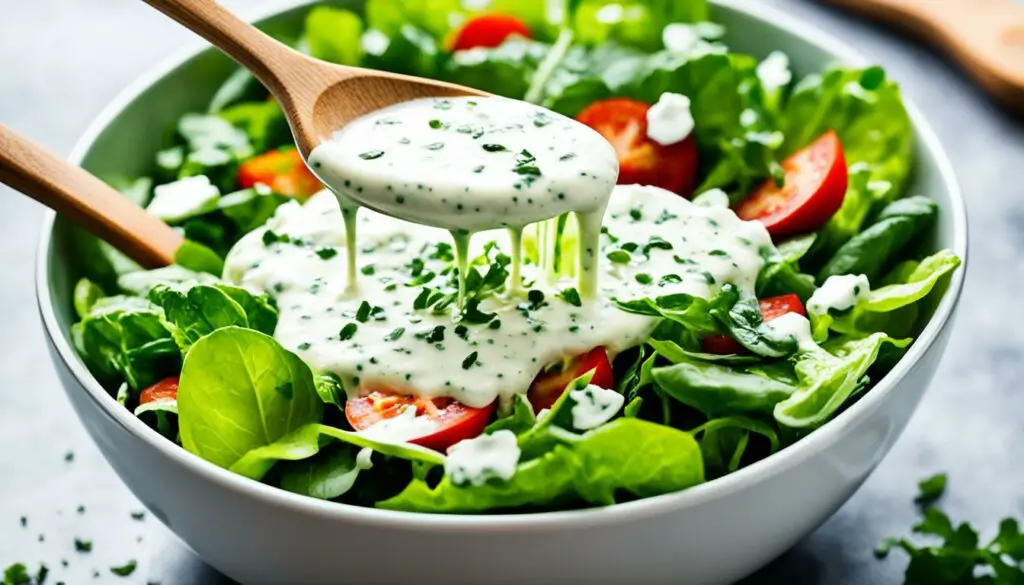
Buttermilk is a versatile ingredient that can add a creamy, tangy element to dressings and sauces, taking them to the next level. Whether you’re making a simple salad dressing or a flavorful sauce, incorporating buttermilk can elevate the flavor profile of the dish and create a velvety texture.
When used in dressings, such as ranch or Caesar dressing, buttermilk adds a refreshing tang that complements the other ingredients. Its creamy consistency blends well with herbs, spices, and other flavorings, resulting in a flavorful and creamy dressing.
Incorporating buttermilk into dressings not only adds a unique twist but also balances the flavors, making each bite more delightful.
Buttermilk can also be incorporated into sauces, like marinara or gravy, to enhance their taste and texture. Its acidity helps to balance the richness of the sauce and adds a subtle tang, making it more enjoyable. Additionally, buttermilk lends a smooth and velvety texture to sauces, creating a rich and satisfying mouthfeel.
Whether you’re drizzling your favorite salad with a tangy buttermilk dressing or smothering your comforting mashed potatoes with creamy buttermilk gravy, the addition of buttermilk in dressings and sauces is a game-changer for your taste buds.
To inspire you further, here’s a table showcasing some popular recipes that use buttermilk in dressings and sauces:
| Recipe | Description |
|---|---|
| Ranch Dressing | A classic dressing made with buttermilk, herbs, and spices, perfect for salads, vegetables, or as a dip. |
| Caesar Dressing | A tangy dressing made with buttermilk, anchovies, garlic, and parmesan cheese, traditionally used in Caesar salads. |
| Buttermilk Marinara Sauce | A twist on traditional marinara sauce, made with buttermilk to add creaminess and tang to pasta dishes. |
| Buttermilk Gravy | A creamy and flavorful gravy made with buttermilk, perfect for topping biscuits, mashed potatoes, or fried chicken. |
By incorporating buttermilk in dressings and sauces, you can create delightful flavor combinations and enhance the overall taste experience. The creamy texture and tangy flavor of buttermilk are sure to impress your family and friends when they try your delicious creations.
Buttermilk in Other Recipes
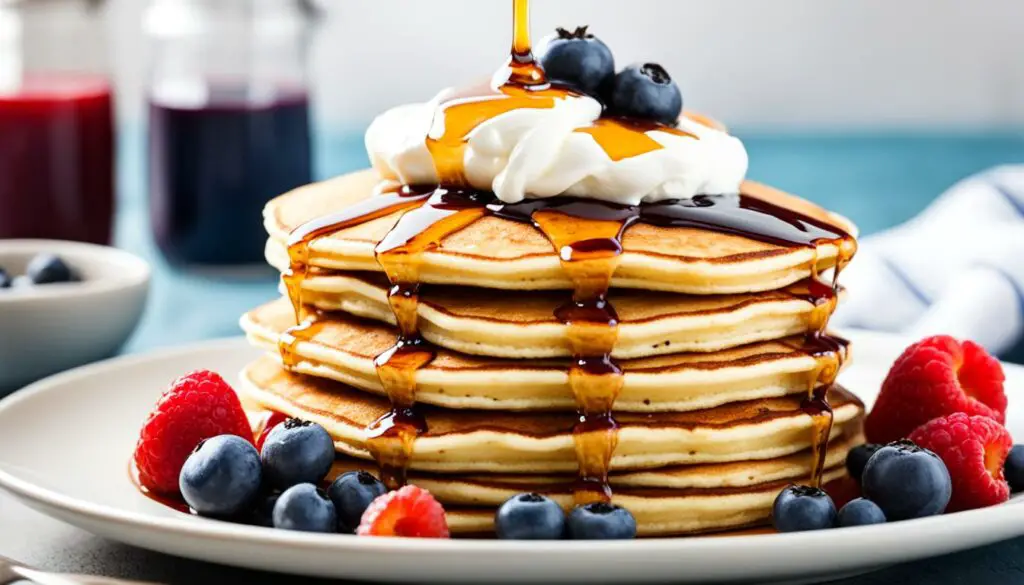
Buttermilk is not just limited to baked goods and marinades. Its tangy and creamy qualities make it a versatile ingredient in various recipes. Whether you’re looking to add flavor to desserts, create healthier mashed potatoes, or enhance the taste of cornbread, buttermilk can be your secret weapon in the kitchen.
Adding Tangy Nuances to Desserts
When it comes to desserts, buttermilk offers a unique flavor profile that can take your sweet treats to the next level. From pies to cakes and panna cotta, incorporating buttermilk adds a subtle tanginess that enhances the overall taste. It brings a delightful depth of flavor and a creamy texture to your favorite desserts.
Healthier and Creamier Mashed Potatoes
If you’re looking to cut down on excess butter and still achieve creamy mashed potatoes, buttermilk is the perfect substitute. Adding buttermilk to your mashed potatoes creates a luscious and velvety texture without the need for excessive amounts of butter. The tanginess of the buttermilk adds a delightful twist and a lighter touch to this classic side dish.
Moisture and Flavor in Cornbread
Savory dishes like cornbread benefit from the addition of buttermilk as well. It adds moisture and a unique tangy flavor that complements the other ingredients in the recipe. Buttermilk ensures that your cornbread stays moist and tender, resulting in a deliciously flavorful side dish.
| Recipe | Ingredients | Instructions |
|---|---|---|
| Peach Buttermilk Pie | Fresh peaches, buttermilk, sugar, eggs, flour, vanilla extract, salt, pie crust | 1. Preheat the oven to 350°F (175°C). 2. Peel and slice the peaches. 3. In a bowl, whisk together buttermilk, sugar, eggs, flour, vanilla extract, and salt. 4. Arrange the peach slices in the pie crust. 5. Pour the buttermilk mixture over the peaches. 6. Bake for 40-45 minutes or until the pie is set. 7. Let it cool before serving. |
| Buttermilk Mashed Potatoes | Potatoes, buttermilk, butter, salt, pepper | 1. Peel and cube the potatoes. 2. Boil the potatoes until tender. 3. Drain the potatoes and return them to the pot. 4. Mash the potatoes with a potato masher or fork. 5. Gradually add buttermilk, butter, salt, and pepper while mashing. 6. Continue mashing until desired consistency is reached. 7. Serve hot. |
| Buttermilk Cornbread | Cornmeal, flour, sugar, baking powder, baking soda, salt, buttermilk, eggs, butter | 1. Preheat the oven to 425°F (220°C). 2. In a large bowl, combine cornmeal, flour, sugar, baking powder, baking soda, and salt. 3. In a separate bowl, whisk together buttermilk, eggs, and melted butter. 4. Pour the wet ingredients into the dry ingredients and stir until just combined. 5. Pour the batter into a greased baking pan. 6. Bake for 20-25 minutes or until golden brown. 7. Allow to cool slightly before serving. |
With buttermilk, you can venture into the unexplored territory of desserts, reinvent classic dishes, and add a delightful tang to your recipes. Embrace the versatility of buttermilk and let it work its magic in your culinary creations.
How to Store Buttermilk
Properly storing buttermilk is essential to maintain its freshness and ensure its long-lasting quality. Here are some tips on storing buttermilk:
- Keep it in the refrigerator: Store your buttermilk in its original container and place it in the refrigerator. The cold temperature helps slow down any bacterial growth and keeps the buttermilk fresh.
- Choose the coldest part: To maintain optimal freshness, store the buttermilk in the coldest part of your fridge, typically in the back or on the bottom shelf. This will help prevent any temperature fluctuations that may impact its quality.
- Check the expiration date: It’s important to pay attention to the expiration date printed on the container. While buttermilk can typically be consumed within two weeks, it is advisable to use it within a week for the best taste and quality.
- Freeze it for later use: If you have leftover buttermilk that you can’t use up within the recommended timeframe, you can freeze it for future use. Before freezing, ensure that the buttermilk still smells fresh and shows no signs of spoilage.
Freezing Buttermilk
To freeze buttermilk, follow these steps:
- Pour the buttermilk into an airtight container or ice cube tray.
- Leave some room for expansion as the buttermilk freezes.
- Seal the container or cover the ice cube tray tightly to prevent freezer burn.
- Label the container with the date to help you keep track of its freshness.
- Place the container in the freezer, where it can be stored for up to three months.
When you’re ready to use the frozen buttermilk, simply thaw it in the refrigerator overnight or defrost it in the microwave using the defrost setting. Before using it, give the buttermilk a good stir to ensure it’s well-mixed.
By properly storing buttermilk, you can extend its shelf life and continue to enjoy its tangy goodness in your favorite recipes.
| Storage Method | Refrigerated Shelf Life | Freezer Shelf Life |
|---|---|---|
| In Original Container | Up to 2 weeks | Up to 3 months |
| Frozen in Airtight Container | N/A | Up to 3 months |
Buttermilk Substitutes
If you don’t have buttermilk on hand, there are several substitutes you can use in your recipes. One popular substitute is to thin plain yogurt with an equal amount of water to mimic the tanginess and thickness of buttermilk. Another option is to use milk and add an acidic ingredient, such as lemon juice or vinegar, to create a similar acidity. Clabbered milk, which is made by adding an acid to milk or cream, can also be used as a substitute. Additionally, there are commercially available buttermilk powders that can be reconstituted with water to provide a similar flavor and texture.
Tangy Yogurt Substitute for Buttermilk
If you’re out of buttermilk, tangy yogurt can come to the rescue. Simply mix the following ingredients:
- 1 cup plain unsweetened yogurt
- 1 cup water
This substitute will replicate the tangy flavor and thickness of buttermilk in your recipes.
Milk with Acidic Ingredient Substitute for Buttermilk
If you don’t have yogurt or buttermilk powder, you can create a substitute using milk and an acidic ingredient like lemon juice or vinegar. Here’s how:
- Mix 1 cup of milk
- Add 1 tablespoon of lemon juice or vinegar
- Let the mixture sit for a few minutes
The acid in the lemon juice or vinegar will mimic the acidity of buttermilk and create a similar flavor profile.
Clabbered Milk Substitute for Buttermilk
Clabbered milk is another alternative to buttermilk that you can make at home. Follow these steps:
- Take 1 cup of milk or cream
- Add 1 tablespoon of an acidic ingredient like lemon juice or vinegar
- Mix well and let it sit at room temperature for 5-10 minutes
The mixture will thicken and develop a tangy flavor, similar to buttermilk. It can be used as a substitute in your recipes.
| Substitute | Ingredients | Method |
|---|---|---|
| Tangy Yogurt | 1 cup plain unsweetened yogurt, 1 cup water | Mix yogurt and water together |
| Milk with Acidic Ingredient | 1 cup milk, 1 tablespoon lemon juice or vinegar | Mix milk and lemon juice/vinegar, let it sit |
| Clabbered Milk | 1 cup milk or cream, 1 tablespoon lemon juice or vinegar | Mix milk/cream and lemon juice/vinegar, let it sit |
Using these substitutes, you can still achieve the tanginess and texture that buttermilk brings to your recipes.
Traditional Uses of Buttermilk
In certain cultures, buttermilk has traditional uses beyond cooking. It is not only a versatile ingredient in recipes but also a popular beverage with a long-standing history in various parts of the world.
Middle Eastern, Arab, and Indian countries, including Pakistan and Nepal, have been consuming buttermilk as a beverage for centuries. In these regions, buttermilk is highly regarded for its refreshing and cooling properties. It is believed to have several health benefits and is often enjoyed on its own, especially during hot summer months.
Similarly, some Germanic and Nordic countries also have a tradition of using buttermilk as a beverage. It is commonly consumed as a refreshing and nutritious drink.
While drinking buttermilk as a beverage is less common today in the United States, it was once more popular in the past, particularly in the southern region. However, the traditional uses of buttermilk in cooking still remain prevalent and cherished.
To give you a visual glimpse of the popularity of buttermilk as a beverage in different cultures, here is a table showcasing its traditional uses in Middle Eastern, Indian, and Germanic/Nordic cuisines:
| Country/Cuisine | Traditional Use |
|---|---|
| Middle Eastern, Arab, Indian (including Pakistan and Nepal) | Consumed as a refreshing and healthful beverage, enjoyed on its own or with meals |
| Germanic, Nordic | Drunk as a refreshing and nutritious beverage |
It’s fascinating to see the diverse ways in which buttermilk is celebrated across cultures, both as a cooking ingredient and a delightful drink.
Now, let’s explore more about the buttermilk variations and alternative products that can provide a similar experience in your recipes in the next section.
Buttermilk Variations and Alternatives
While traditional buttermilk is a popular choice for adding a tangy twist to recipes, there are also variations and alternative products that can provide similar qualities. These options can be especially helpful if you don’t have buttermilk on hand or prefer a different flavor profile. Let’s explore some of the variations and alternatives to buttermilk:
Variations of Buttermilk
One variation of buttermilk is kefir. Kefir is a fermented dairy product that shares similarities with buttermilk. It has a tangy flavor and creamy texture, making it a suitable substitute in many recipes. The tanginess of kefir can enhance the flavor of baked goods and dressings.
Alternative Products Similar to Buttermilk
If you’re looking for non-dairy options, there are alternatives that can mimic the tanginess and moisture of buttermilk. For example, almond milk or soy milk can be mixed with lemon juice or vinegar to create a homemade buttermilk substitute. These alternatives may not have the exact same flavor or texture as traditional buttermilk, but they can still add tanginess and moisture to your dishes.
Here’s a simple recipe for a homemade buttermilk substitute using almond milk:
- Pour 1 cup of almond milk into a measuring cup.
- Add 1 tablespoon of lemon juice or white vinegar to the almond milk.
- Stir the mixture and let it sit for about 5 minutes to allow the almond milk to curdle.
- Use the homemade buttermilk substitute as you would use traditional buttermilk in your recipes.
Remember, these alternatives may alter the taste slightly, but they can still provide the tanginess and moisture that buttermilk brings to recipes.
Tips for Using Buttermilk in Recipes
When it comes to using buttermilk in your recipes, there are a few tips and best practices that can help you achieve the best results. Whether you’re baking fluffy pancakes or incorporating buttermilk into dressings and sauces, these tips will ensure a delightful culinary experience.
1. Shake Well: Before using buttermilk, make sure to give it a good shake. Buttermilk can separate into layers, and shaking it well ensures an even distribution of the ingredients, resulting in a harmonious blend of flavors in your dish.
2. Adjust Leavening Agents: Buttermilk’s acidity can affect the leavening process in baking. If your recipe calls for baking powder, consider reducing the amount slightly when using buttermilk. This adjustment will help maintain the perfect balance and ensure your baked goods rise to perfection.
3. Embrace Experimentation: The versatility of buttermilk opens up a world of possibilities in the kitchen. Don’t be afraid to get creative and experiment with different recipes and flavor combinations. From savory dishes to sweet treats, buttermilk can add a tangy twist and elevate your favorite dishes to new heights.
“Using buttermilk in your recipes allows you to explore new flavors and textures. Embrace experimentation and let your culinary creativity shine.”
4. Keep It Cold: Buttermilk’s freshness is best preserved when stored in the refrigerator. Make sure to keep it in the coldest part of your fridge, such as the back, to maintain its flavor and quality for as long as possible.
5. Don’t Waste: If you find yourself with leftover buttermilk that you can’t use within its recommended shelf life, freezing it is a great option. Simply pour the buttermilk into an airtight container and place it in the freezer. When ready to use, thaw it in the refrigerator overnight. Freezing buttermilk helps extend its usability, ensuring you never waste a drop.
By following these tips and incorporating buttermilk into your recipes, you can enjoy the unique flavors and benefits it brings to your cooking. So go ahead and explore the wonders of buttermilk in your culinary adventures!
| Tips for Using Buttermilk in Recipes: |
|---|
| Shake well before using |
| Adjust leavening agents |
| Embrace experimentation |
| Keep it cold |
| Don’t waste – freeze it |
Conclusion
Buttermilk is a versatile ingredient that can add a unique taste and creamy tang to your recipes. Whether you’re baking fluffy pancakes, marinating tender chicken, or adding a tangy touch to dressings and sauces, buttermilk can elevate the flavors and textures of your dishes. Its acidity not only enhances the taste but also helps to tenderize meat and stabilize sauces.
If you don’t have buttermilk on hand, there are various substitutes and alternatives available that can still provide similar qualities in your cooking. Whether it’s thinning plain yogurt, mixing non-dairy milk with lemon juice, or exploring fermented dairy products like kefir, you can still enjoy the benefits of buttermilk even if it’s not readily available.
Don’t be afraid to experiment with different recipes and flavor combinations to unlock the versatile magic of buttermilk. Shake it well before using it to ensure even distribution, adjust leavening agents accordingly, and get creative in incorporating this valuable ingredient. With buttermilk, you can take your favorite dishes to the next level and delight your taste buds with its tangy and creamy goodness.
FAQ
Why should I use buttermilk in recipes?
Buttermilk adds flavor and texture to a wide range of recipes, enhancing the taste and tenderness of dishes.
What is buttermilk?
Buttermilk is a fermented, low-fat liquid that is a byproduct of making butter.
How can I use buttermilk in baking?
Buttermilk can be used in pancakes, waffles, biscuits, and cakes to create light and fluffy textures and add a tangy flavor.
How can buttermilk be used as a marinade?
Buttermilk can be used as a marinade for chicken and other proteins to tenderize the meat and add moisture.
How can buttermilk be used in dressings and sauces?
Buttermilk can be used as a base for creamy dressings and sauces, adding a tangy and creamy element to the dish.
What other recipes can I use buttermilk in?
Buttermilk can be used in various recipes, such as pies, mashed potatoes, and cornbread, to add a tangy and creamy touch.
How should I store buttermilk?
Buttermilk should be stored in the refrigerator in its original container, preferably in the coldest part of the fridge.
What can I use as a substitute for buttermilk?
Plain yogurt, milk with lemon juice or vinegar, or commercially available buttermilk powders can be used as substitutes for buttermilk.
Are there traditional uses for buttermilk beyond cooking?
In some cultures, buttermilk is consumed as a beverage and is believed to have health benefits.
Are there variations of buttermilk or alternative products?
Kefir and non-dairy milk alternatives mixed with lemon juice or vinegar can serve as substitutes for buttermilk.
What are some tips for using buttermilk in recipes?
Shake the buttermilk well before using it, adjust the amount of baking powder, and experiment with different recipes and flavor combinations.
Can buttermilk be frozen?
Yes, buttermilk can be frozen for up to three months if properly stored in the freezer.

